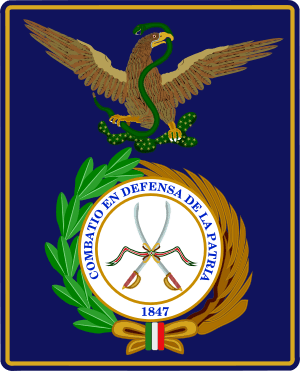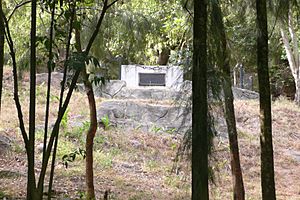Battle of Chapultepec facts for kids
Quick facts for kids Battle of Chapultepec |
|||||||
|---|---|---|---|---|---|---|---|
| Part of the Mexican–American War, Battle for Mexico City |
|||||||
 Battle of Chapultepec, Carl Nebel, 1851 |
|||||||
|
|||||||
| Belligerents | |||||||
| Commanders and leaders | |||||||
| Strength | |||||||
|
7,200 Total Army including 400 Marine Corps Engaged at the Battle on Chapultepec approx 2,000 |
1,232 Total Mexican Army 832 soldiers in the Castle 400 soldiers from San Blas Battalion |
||||||
| Casualties and losses | |||||||
| 138 killed 673 wounded 29 missing |
c.600 killed (most from San Blas Battalion) The rest were captured or wounded |
||||||
The Battle of Chapultepec was an important fight during the Mexican–American War. It happened on September 13, 1847, near Mexico City. American soldiers fought against Mexican forces defending Chapultepec Castle. This castle was on top of a 200-foot (61-meter) hill. It was a very important spot for defending Mexico City.
This battle was part of the plan to capture Mexico City. General Winfield Scott led the U.S. Army, which had about 7,200 soldiers. General Antonio López de Santa Anna led the Mexican army, with about 25,000 soldiers. At Chapultepec, about 2,000 U.S. soldiers attacked. The Mexican defenders included young cadets from the Military Academy. When Mexico lost this battle, it opened the way for the Americans to take the center of Mexico City.
In Mexico, this battle is famous for the bravery of six young cadets, known as the Niños Héroes. They are said to have fought to the death rather than surrender. One even wrapped himself in the Mexican flag before jumping from the castle. American stories also show the battle from their side. Even though the battle lasted only about 60 to 90 minutes, it is very important in the history of both countries.
Contents
Scott's Plan to Take Mexico City
General Scott took a big risk by marching his army inland from the port of Veracruz. This meant he was far from his supply lines. He won a major fight at Cerro Gordo. Then, he captured Mexico's second-largest city, Puebla, with almost no fighting. After that, he moved closer to the capital.
Scott avoided the main road to Mexico City because it was heavily defended. Instead, he made a new road that went south around two lakes. This led him to the town of San Agustín. Mexican defenders blocked the path to the capital at the Hacienda of San Antonio. There were swamps to the north and a lava field to the south.
On August 20, U.S. forces fought the Mexican army at Contreras. The Mexicans were defeated, and the U.S. army kept moving forward. Santa Anna then fortified an old convent at Churubusco, where fierce fighting took place. After this battle, there was a two-week break in the fighting.
On September 8, 1847, U.S. forces fought the costly Battle of Molino del Rey. They pushed the Mexicans away from positions near Chapultepec Castle. This area guarded Mexico City from the west. On September 11, General Scott met with his generals and engineers. Scott wanted to attack Chapultepec Castle. Most of his officers, including Captain Robert E. Lee, wanted to attack through the southern gates of the city. However, a young lieutenant named P. G. T. Beauregard gave a speech. He convinced General Franklin Pierce to agree with Scott's plan to attack from the west.
The Battle
General Santa Anna was in charge of the Mexican army in Mexico City. He knew that Chapultepec Castle was a key position for defending the city. The castle was on top of a 200-foot (61-meter) hill. It was also used as the Mexican Military Academy. Santa Anna had more soldiers than Scott in total. However, he had to defend many different places. He did not know where the Americans would attack.
He did not have enough soldiers to defend both the southern roads into Mexico City and Chapultepec Castle. At Chapultepec, General Nicolás Bravo had fewer than 1,000 men. This included 200 young cadets, some as young as 13 years old. The Batallón de San Blas also defended the castle. It was led by Lieutenant Colonel Felipe Xicoténcatl, who became a hero of the battle.
Santa Anna thought the main attack would come from the south. So, he spent time and sent soldiers to prepare defenses there. He did not realize his mistake until the U.S. troops were already on the hill. By then, it was too late to send more help.
Chapultepec Castle was built as a fancy home, not a fort. Later, it became a military academy. It was in a good spot for defense, but its stone walls could be damaged by cannons. U.S. forces used their heavy cannons to bombard the castle before their soldiers attacked. The Mexican defenders tried to make their defenses stronger with trenches and sandbags. But during the cannon attack, they had nowhere safe to hide. They could not defend against the long-distance cannon fire. The destruction of their walls and defenses made many defenders lose hope. Some started to leave their positions.
Only when the bombardment lasted all day did Santa Anna realize the main attack was on Chapultepec. If he sent soldiers there, they would be out in the open on the flat land below the hill. They would be easy targets for U.S. cannons. They could not reach the hill to help the defenders during the bombardment. Santa Anna talked with Nicolás Bravo. He admitted that many of his soldiers were losing morale. They would likely run away if sent into a situation with many casualties.
General Scott put together two groups of about 250 men each. These groups included 40 Marines. The first group, led by Captain Samuel Mackenzie, would attack from the east side of the hill. The second group, led by Captain Silas Casey, would advance along the Tacubaya Road.
The U.S. forces started firing their cannons at Chapultepec at dawn on September 12. They stopped at dark and started again at first light on September 13. At 8:00 am, the cannon fire stopped. General Scott then ordered his soldiers to attack. Three groups of soldiers moved forward.
The attack was difficult. General Pillow was shot in the foot. The attack slowed down when Mexican cannons fired on them. One U.S. commander, Colonel Truman B. Ransom, was killed. More U.S. soldiers arrived to help the attack. Soon, the American soldiers reached the castle walls. The Voltigeurs, a type of U.S. soldier, quickly put their flag on the castle's wall.
By 9:00 am, General Bravo surrendered to the New York Regiment. The American flag was now flying over the castle. Santa Anna watched the Americans take Chapultepec. An aide said, "Let the Mexican flag never be touched by a foreign enemy." Santa Anna also said, "I believe if we were to plant our batteries in Hell, the damned Yankees would take them from us."
Los Niños Héroes
During the battle, five Mexican military cadets and one of their teachers refused to retreat. General Bravo had ordered them to fall back. But these six fought until they died. Their names were Lieutenant Juan de la Barrera and cadets Agustín Melgar, Juan Escutia, Vicente Suárez, Francisco Márquez, and Fernando Montes de Oca. They were all between 13 and 19 years old.
A famous story says that Juan Escutia, the last of the six, grabbed the Mexican flag. He wrapped it around himself and jumped off the castle. He did this to stop the flag from falling into enemy hands. In 1967, Gabriel Flores painted a mural showing Los Niños Héroes. The mural is on the ceiling of the palace. It shows Escutia wrapped in the flag, falling from above. A monument in Chapultepec Park honors their courage. These cadets are remembered in Mexican history as los Niños Héroes, which means "the Child Heroes" or "Heroic Cadets."
Saint Patrick's Battalion
The Saint Patrick's Battalion was a group of former United States Army soldiers. They had joined the Mexican side. Thirty of these men were captured earlier at the Battle of Churubusco. During the Battle of Chapultepec, they faced consequences for changing sides.
Fights for the City Gates
General Scott arrived at the castle and was cheered by his soldiers. Scott sent General William J. Worth's division to attack the San Cosme Gate. This was the main attack. Other U.S. brigades also advanced along the causeway.
General Quitman quickly gathered soldiers at Chapultepec. He then headed down the Belén Causeway as a distraction. He stopped at the Belen Garita, which was a gate. Mexican soldiers defended this gate. Some Mexican troops started to leave their positions. When the Mexican commander ran out of ammunition, he pulled back. Quitman's soldiers broke through the Belén Gate at 1:20 pm. General Scott later praised them, saying, "Brave Rifles, you have gone through fire and come out steel."
Worth started his advance down the San Cosme causeway at 4:00 pm. He had just fought off an attack by Mexican cavalry. Worth's soldiers used the arches of an aqueduct to move forward. Other soldiers used a tunnel made by engineers. Lieutenant Ulysses S. Grant and some soldiers used a church bell tower. They placed a small cannon there. Another officer, Raphael Semmes, did the same on the other side of the road.
Lieutenant George Terrett led a group of U.S. Marines. They went behind the Mexican defenders. They climbed to a roof and fired down on the Mexican cannon operators. By 6 pm, Worth had broken through the gate. The Mexican defenders scattered, many retreating into the main armory. As night fell, Worth fired five mortar rounds into the city. They landed near the National Palace.
Aftermath
The city was not fully captured yet. Santa Anna still had 5,000 soldiers in the armory and 7,000 in other parts of the city. Six of his generals were taken prisoner. At 1 AM the next day, Santa Anna ordered his troops to leave the city. City officials then met with Scott at 4 AM. By 7 am, the American flag was flying over the armory. Historians estimate that about 3,000 Mexican soldiers were killed, wounded, or captured.
Legacies
The U.S. Marines remember their efforts in this battle. The first lines of the "Marines' Hymn" are "From the Halls of Montezuma...". This refers to Chapultepec Castle.
Many U.S. Army officers who fought in this invasion later became generals. They fought on both sides during the American Civil War. These included Ulysses S. Grant, Robert E. Lee, George Pickett, and Stonewall Jackson.
U.S. Marine tradition says that the red stripe on their blue dress uniform is called the "blood stripe". This is because many Marine non-commissioned officers and officers died while storming Chapultepec Castle in 1847.
In Mexico, the battle has a special place in history. The capture of Chapultepec led to Mexico City falling to the invaders. But the fierce defense by the military cadets is celebrated. The six cadets who died are seen as heroes who fought to protect Mexico's honor. Their bravery is praised, especially compared to some Mexican Army generals, like Antonio López de Santa Anna, who were blamed for Mexico's defeat.
In 1947, U.S. President Harry S. Truman placed a wreath on the monument to the Niños Héroes. This was a friendly gesture after Mexico helped the U.S. in World War II.
Images for kids
See also
 In Spanish: Batalla de Chapultepec para niños
In Spanish: Batalla de Chapultepec para niños










